Understanding the 47 Ohm Resistor: Applications and Selection
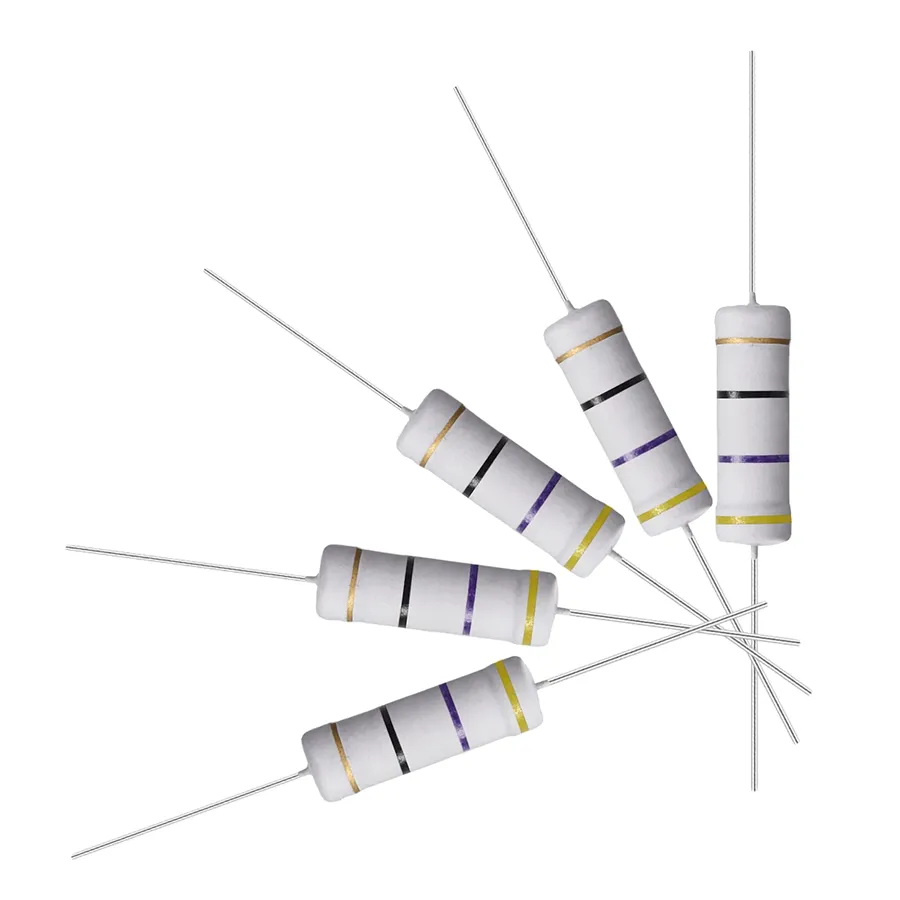
In the world of electronics, the humble 47 ohm resistor plays a crucial role, much like how a well-balanced society needs certain limitations to maintain harmony. This component, often small in size but significant in function, acts as a gatekeeper for electrical current, allowing for precise control in a variety of circuits. Just as our bodies rely on natural resistance to regulate blood flow, electronic circuits need resistors like the 47 ohm to function correctly. In this article, we will delve into the world of the 47 ohm resistor, examining its uses, types, and how to ensure it perfectly fits your electronic needs.
What is a 47 Ohm Resistor?

A 47 ohm resistor is a fundamental electronic component designed to impede the flow of electrical current, presenting a specific resistance of 47 ohms. This specific resistance value is frequently employed in various electronic circuit designs to control current, manage voltage drops, or provide a known load. The core function of a resistor, including the 47 ohm variant, is to convert electrical energy into heat energy, thereby controlling current within a circuit.
At its core, resistance, measured in ohms (Ω), represents the opposition to current flow. A 47 ohm resistor, therefore, offers a moderate level of resistance, making it a common choice for many electronic applications where precise current limiting is required. Understanding the fundamental concept of resistance is crucial for selecting and utilizing resistors effectively within circuits.
Types of 47 Ohm Resistors
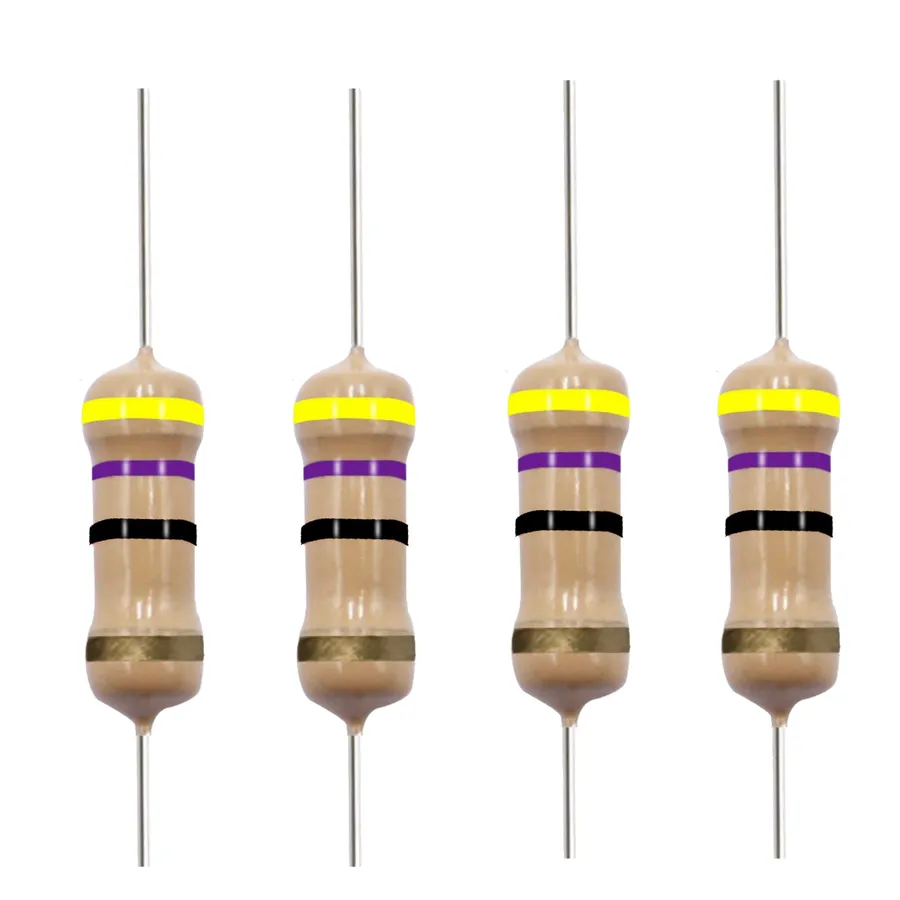
47 ohm resistors, while all providing the same nominal resistance, come in a variety of types, each tailored to specific applications and performance requirements. These variations are primarily distinguished by their construction, materials, and physical form, affecting factors such as tolerance, power rating, and temperature stability.
- Through-Hole (Axial) Resistors
These resistors have leads that are inserted into holes on a circuit board. They are easy to handle and solder, making them suitable for prototyping and educational purposes. Common types include carbon film, metal film, and wire-wound. - Surface Mount (SMD) Resistors
Designed for automated assembly on printed circuit boards, SMD resistors are compact and have no leads. They come in various sizes, such as 0805, 0603, and 0402, each with specific power handling capabilities. They are prevalent in modern electronic devices. - Metal Film Resistors
Metal film resistors are known for their high precision, low temperature coefficient, and low noise. They are constructed by depositing a thin metal film onto a ceramic substrate. This type is often preferred for applications demanding stable performance. - Carbon Film Resistors
Carbon film resistors are made by depositing a thin carbon film onto an insulating substrate. While they are more affordable than metal film resistors, they typically have lower tolerance and higher temperature coefficients, making them suitable for less demanding applications. - Wire-Wound Resistors
Wire-wound resistors are constructed by winding a wire of a specific alloy around an insulating core. These resistors are known for their high power handling capacity and are often used in power supply circuits. However, they may exhibit higher inductance at high frequencies. - Metal Oxide Film Resistors
These resistors are made by depositing a metal oxide film onto a ceramic substrate. They offer a good compromise between cost and performance, with relatively good tolerance and temperature coefficients. They are often preferred over carbon film resistors in many applications due to better stability.
| Resistor Type | Construction | Typical Tolerance | Power Rating | Application |
|---|---|---|---|---|
| Through-Hole | Leaded for insertion into PCB holes | 1% - 10% | 1/4W - 2W | Prototyping, education |
| Surface Mount (SMD) | Leadless for surface mounting | 0.1% - 5% | 1/16W - 1W | Modern electronics |
| Metal Film | Thin metal film on ceramic | 0.1% - 1% | 1/8W - 1/2W | High precision, low noise circuits |
| Carbon Film | Thin carbon film on insulator | 2% - 10% | 1/4W - 2W | General purpose applications |
| Wire-Wound | Wire coiled around a core | 1% - 5% | 1W - 50W | High power circuits |
| Metal Oxide Film | Metal oxide film on ceramic | 1% - 5% | 1/4W - 3W | General purpose, improved stability |
47 Ohm Resistor Color Code
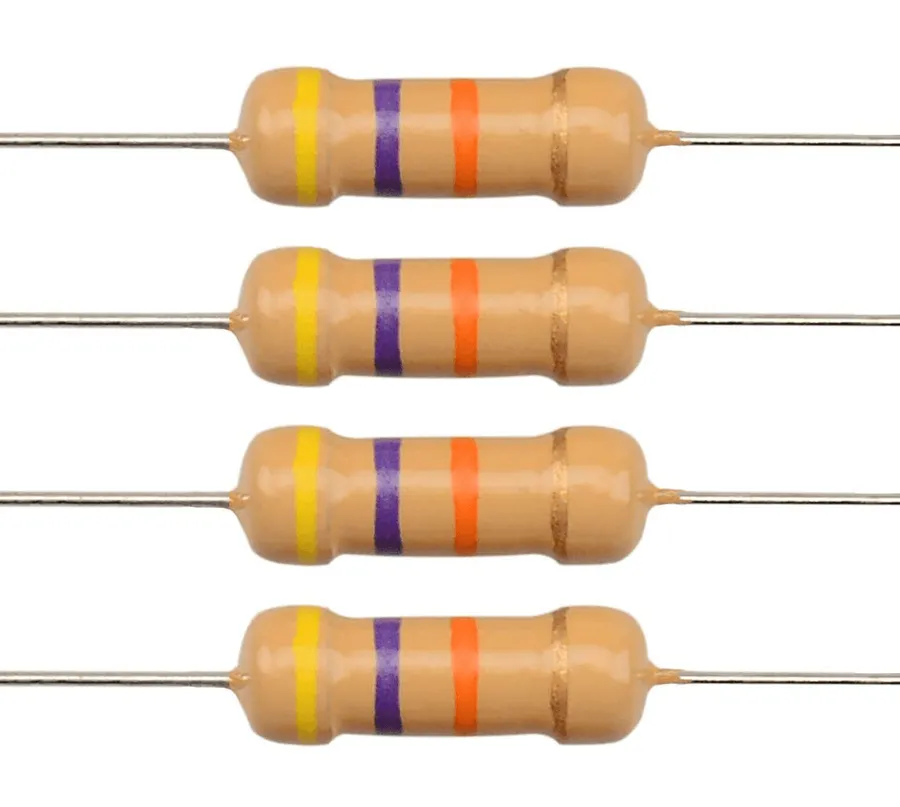
The color code on a 47 ohm resistor is a standardized method for indicating its resistance value. This system uses colored bands to represent numerical values and multipliers, enabling quick and accurate identification of the resistor's specifications without needing to rely on printed text, which can be too small, or may not exist. Understanding this code is fundamental for electronics work.
- Standard 4-Band Resistor:
Most commonly, 47 ohm resistors use a 4-band color code. The first two bands represent the significant digits of the resistance value, the third band is the multiplier, and the fourth band indicates the tolerance. For a 47 ohm resistor, the color bands are typically: Yellow (4), Violet (7), Black (x1), Gold (5% tolerance) or Brown (1% tolerance). - 5-Band Resistor Variations
High-precision resistors use a 5-band code. The first three bands give the digits, the fourth band is a multiplier, and the fifth indicates the tolerance. The 47 ohm resistor with 5 bands: Yellow(4), Violet(7), Black(0), Black(x1), and then a tolerance band(e.g. Brown for 1%, Red for 2%, Green for 0.5%, or Violet for 0.1% tolerance). - Understanding Color Values
Each color corresponds to a number: Black (0), Brown (1), Red (2), Orange (3), Yellow (4), Green (5), Blue (6), Violet (7), Gray (8), and White (9). Gold and Silver are used for tolerance, or as a decimal multiplier. A gold multiplier band indicates multiply by 0.1, and a silver one is multiply by 0.01. - Practical Application
When reading the bands, hold the resistor so that the tolerance band (usually gold or silver) is on your right, then read the colors from left to right. This will give you the resistor's value and tolerance. Incorrect interpretation will result in circuit problems.
Key Specifications of a 47 Ohm Resistor
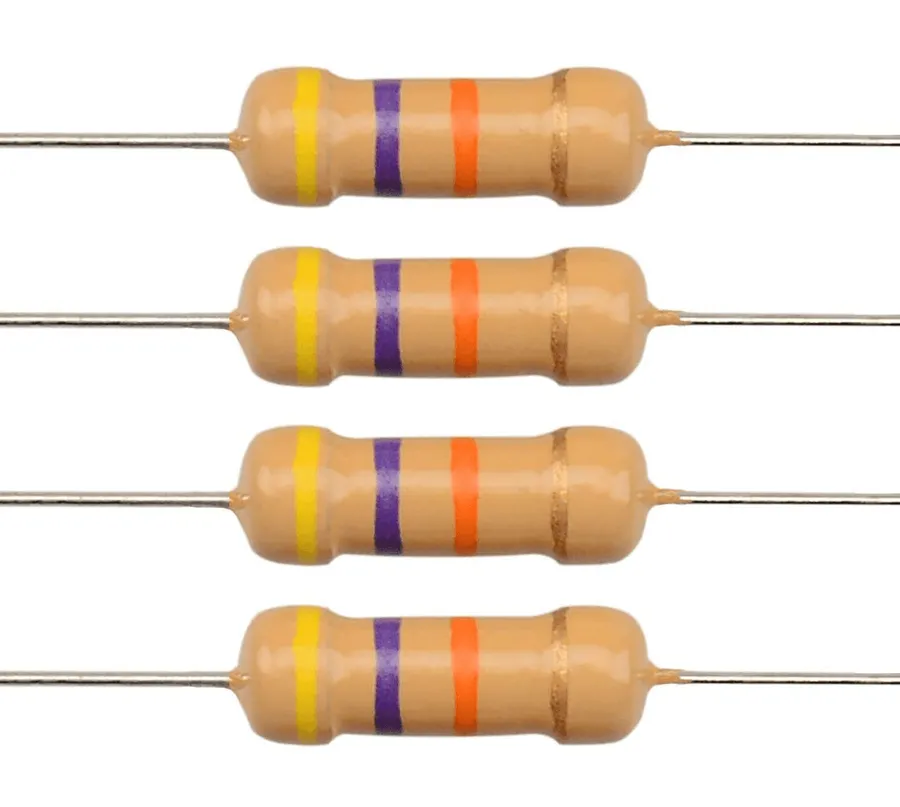
Selecting the appropriate 47 ohm resistor for a given application requires a thorough understanding of its key specifications. These specifications, including resistance, tolerance, power rating, temperature coefficient, and voltage rating, directly influence the resistor's performance and suitability within a circuit. Each parameter plays a crucial role in ensuring the circuit operates as designed without component failure or performance degradation.
| Specification | Description | Importance | Impact |
|---|---|---|---|
| Resistance Value | The nominal resistance of the resistor, specified as 47 ohms. | Fundamental to the resistor's function, determines the amount of current it limits. | Incorrect resistance can lead to improper circuit operation or failure. |
| Tolerance | The allowable deviation from the nominal resistance, typically expressed as a percentage (e.g., 1%, 5%). | Indicates the precision of the resistor; affects the accuracy of circuit parameters. | A higher tolerance resistor may introduce inaccuracies, while a lower tolerance resistor will provide more precise results. |
| Power Rating | The maximum power the resistor can safely dissipate as heat, specified in watts (W) (e.g., 1/4W, 1/2W, 1W, 2W). | Essential to prevent overheating and potential failure of the resistor. | Exceeding the power rating can lead to resistor burnout and circuit damage. |
| Temperature Coefficient | Describes how the resistance changes with temperature, typically expressed in parts per million per degree Celsius (ppm/°C). | Important in applications where temperature changes are expected, impacts circuit stability. | Significant temperature variation can alter the resistance value causing unexpected behavior in the circuit. |
| Voltage Rating | The maximum voltage that can be safely applied across the resistor. | Critical to prevent insulation breakdown and potential failure. | Exceeding the voltage rating can result in arcing, resistor damage and complete failure. |
Applications of 47 Ohm Resistors
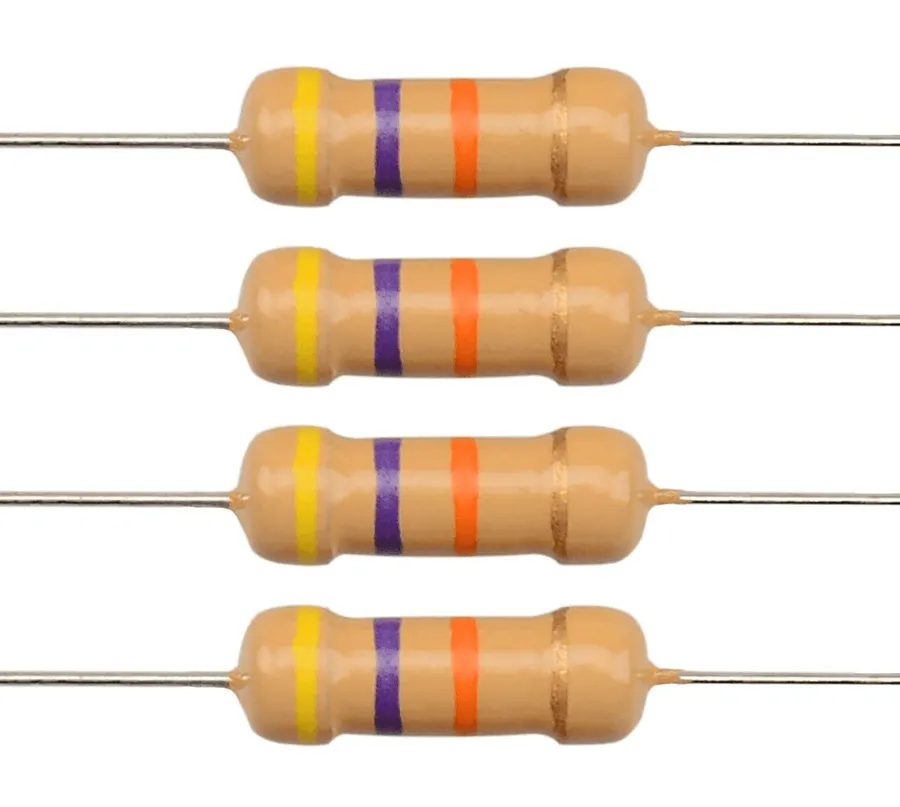
The 47 ohm resistor, a ubiquitous component in electronics, plays a critical role in numerous applications due to its ability to precisely limit current flow and manage voltage. Its common value makes it versatile for a wide range of circuit designs. We will delve into specific real-world applications of 47 ohm resistors, demonstrating their essential function in various electronic systems.
- Current Limiting
A primary application of the 47 ohm resistor is current limiting. When placed in series with a load, it restricts the amount of current passing through the circuit, which is crucial for protecting sensitive components like LEDs, microcontrollers, and sensors from damage caused by excessive current. For instance, in LED circuits, a 47 ohm resistor can regulate the current to the specified operating range, ensuring the longevity and performance of the LED. - Voltage Division
47 ohm resistors, in combination with other resistors, form voltage dividers. This configuration reduces a higher voltage to a lower level suitable for the specific application. The 47 ohm resistor can be part of the voltage divider network to provide a specific voltage at a tap. For example, using a 47 ohm resistor in a simple divider circuit can create a specific voltage for biasing a transistor amplifier. - LED Lighting Circuits
In LED circuits, the 47 ohm resistor is a common choice for current limiting. LEDs have a forward voltage drop and excessive current can damage them. The 47 ohm resistor placed in series, can limit the current, ensuring the LED operates within its specifications. This application can be observed in indicator lights, backlight displays, and decorative LED setups. - Audio Circuits
In audio circuits, 47 ohm resistors are used for impedance matching, feedback, and gain control. They can adjust the signal levels, reduce noise, and adjust the overall sound output. In low-level audio systems or high-frequency signal lines, these resistors provide controlled signal transmission which can make the difference between a functioning circuit or not. They can be part of attenuators and filters in audio equipment. - Circuit Protection
47 ohm resistors can function as a protection element in circuits. They limit fault current in the event of a short circuit or component failure, thereby helping to prevent further damage. While not a primary protection device (like fuses), they contribute to overall circuit safety. They are often used in combination with other protection devices.
Selecting the Right 47 Ohm Resistor

Selecting the appropriate 47 ohm resistor for a specific application requires a thorough understanding of the circuit's demands and the resistor's specifications. Key factors include power requirements, operating temperature, and the necessary tolerance. This section provides practical guidance for making informed decisions.
Begin by calculating the power dissipation. Use the formula P=I^2*R, where P is power, I is current, and R is resistance (47 ohms in this case). The chosen resistor's power rating should exceed this calculated value to ensure reliable operation and to prevent overheating which can damage the resistor and other components, potentially causing circuit malfunction or failure. A general guideline is to select a resistor with a power rating at least twice the calculated power dissipation. Next, consider the operational environment. High ambient temperatures can increase the resistor's temperature, which can affect its performance and lifespan, meaning that high operating temperatures require a higher rated resistor and can impact the resistor’s tolerance, which defines the acceptable range of variation in resistance value. Precision applications might necessitate lower tolerance resistors, e.g., 1% or even 0.1%, whereas less critical applications can function adequately with a 5% or even 10% tolerance resistor. Lastly, analyze the circuit design to ensure optimal performance, considering all factors collectively is imperative.
| Parameter | Consideration | Impact |
|---|---|---|
| Power Rating | Calculated Power Dissipation + Safety Margin | Prevents overheating, ensures reliability |
| Tolerance | Precision of Resistance Required | Affects accuracy in critical applications |
| Temperature Coefficient | Ambient Operating Temperature Range | Influences resistance value changes with temperature |
| Voltage Rating | Circuit's maximum voltage | Prevents breakdown of the resistor material |
Frequently Asked Questions About 47 Ohm Resistors
This section addresses common questions regarding 47 ohm resistors, providing concise and informative answers to enhance understanding and aid in practical application. The following questions cover essential aspects from color coding to safe operating currents, offering insights necessary for effective use.
- What is the color code for a 47 ohm resistor?
The color code for a 47 ohm resistor is typically yellow, violet, and black, and gold or brown depending on the tolerance. The first band (yellow) represents '4', the second band (violet) represents '7', and the third band (black) represents the multiplier of 1, or 10^0. The fourth and fifth bands indicate tolerance, usually gold (±5%) or brown (±1%). This indicates a 47 ohm resistor. - How do I determine the color code for a 0.47 ohm resistor?
For a 0.47 ohm resistor, the color code would be different since we are dealing with a decimal resistance value. It may require the use of five-band color code. Using a 5 band resistor, the color code would be: black, yellow, violet, silver and the last band will indicate the tolerance. The key difference is the silver band being the multiplier of 0.01. Due to the low resistance, 0.47 ohm resistor is often a shunt resistor. - What is the current through a 47 Ω resistor in a circuit?
The current through a 47 ohm resistor depends on the voltage applied across it, as dictated by Ohm's Law (I = V/R). For example, if a 5V voltage source is connected across the 47 ohm resistor, the current will be approximately 0.106 amperes (5V / 47Ω = 0.106A). Without knowing the circuit voltage, it is impossible to give an exact current. It should always be calculated based on the circuit conditions using Ohm's Law. - What is the maximum safe current through a 47 ohm, 2W resistor?
The maximum safe current through a 47 ohm, 2W resistor is determined by its power rating and resistance using the formula: P = I²R. Rearranging this to solve for current, we get I = sqrt(P/R). For this case, I = sqrt(2W / 47Ω) = sqrt(0.0426) ≈ 0.206A. Therefore, the maximum safe current is approximately 0.206 amps. Exceeding this current can cause the resistor to overheat and potentially fail. - Can a 47 ohm resistor be used for LED current limiting?
Yes, a 47 ohm resistor is frequently used for LED current limiting, particularly in low-voltage circuits. Its resistance value helps to limit the current flowing through an LED to prevent damage and ensure the LED operates within its specified current range. The exact value is chosen based on the LED's forward voltage drop and the supply voltage. - Where can I find a 47 ohm resistor?
47 ohm resistors are widely available from electronics component distributors both online and in brick-and-mortar stores. Common places to purchase include distributors such as Digikey, Mouser, Amazon and others. They are a common value which makes them easy to locate. You should compare the suppliers based on your needs. - Are 47 ohm resistors typically surface mount or through-hole?
47 ohm resistors are available in both surface mount (SMD) and through-hole (axial) packages. SMD resistors are usually used in automated manufacturing processes. Through-hole resistors are easier to handle and prototype on breadboards.
Comparing Different Types of 47 Ohm Resistors
Selecting the appropriate 47 ohm resistor requires a thorough understanding of the characteristics of different types, including metal film, carbon film, and wire-wound resistors. Each type offers unique advantages and disadvantages concerning cost, temperature sensitivity, and power handling capabilities, influencing their suitability for specific applications.
| Feature | Metal Film Resistor | Carbon Film Resistor | Wire-Wound Resistor |
|---|---|---|---|
| Cost | Moderate | Low | High |
| Tolerance | Typically 0.1% - 1% | Typically 2% - 5% | Typically 1% - 5% |
| Power Rating | Low to Moderate (up to few watts) | Low to Moderate (up to few watts) | High (can be 10+ watts) |
| Temperature Coefficient | Low (50-100 ppm/°C) | Moderate (250-1000 ppm/°C) | Low (20-200 ppm/°C) |
| Stability | Excellent | Good | Good |
| Noise | Low | Moderate | Low |
| Applications | Precision circuits, audio equipment | General purpose, low-cost applications | High power circuits, power supplies |
| Inductance | Low | Low | Higher, can act as inductor |
Practical Tips for Working with 47 Ohm Resistors
Working with 47 ohm resistors, like any electronic component, requires careful handling to ensure their performance and longevity. Proper soldering techniques, handling, and storage practices are essential for both beginners and intermediate users to prevent damage and maintain circuit reliability. This section provides practical advice to optimize your workflow.
- Soldering Best Practices
When soldering a 47 ohm resistor, use a temperature-controlled soldering iron to avoid overheating. Apply solder quickly and evenly to the leads, ensuring a solid connection without excessive heat exposure. Use a suitable flux to improve solder flow and joint quality. - Handling Precautions
Avoid bending or stressing the resistor leads excessively, as this can cause damage or alter the internal resistance. When handling, use tweezers or antistatic tools, particularly for surface mount (SMD) resistors, to prevent physical damage and electrostatic discharge (ESD). - Proper Storage Techniques
Store 47 ohm resistors in a dry, cool environment, away from direct sunlight and humidity. Organize resistors in labeled compartments or containers to prevent mixing and ease identification. For bulk storage, use antistatic bags or conductive foam to protect from ESD. - Heat Management during Soldering
Minimize heat exposure by using a soldering iron with the correct tip and temperature setting, avoiding prolonged contact of the soldering iron to the resistor. A heat sink can be used for sensitive resistors to dissipate excess heat during soldering, preventing damage from thermal stress. - Avoiding Physical Damage
Be cautious when handling resistors during assembly and disassembly of circuits. Avoid bending leads beyond their limits or exerting unnecessary force on the resistor body. If a resistor is visibly damaged, it's crucial to replace it to maintain circuit reliability. - SMD Resistor Handling
SMD resistors require special attention. Use fine-tipped tweezers or a vacuum pick-up tool for placement. When soldering, consider using solder paste and a reflow method, or fine-tipped soldering iron. Proper storage in anti-static tape is essential.
The 47 ohm resistor, a cornerstone of electronics, is more than just a simple component; it's a critical element for controlling electrical current, just as social laws and regulations create constraints to facilitate effective interactions. From understanding its color code and specifications to its diverse applications, a solid grasp of this resistor can significantly enhance your electronic projects. Whether you are a hobbyist or a professional, knowing how to properly select and use a 47 ohm resistor, or any component for that matter, empowers you to create reliable and functional circuits. It's this ability to regulate electrical flow, much like how rules regulate society, that makes it an indispensable part of any electronics toolkit.
 AnyPCBA
AnyPCBA